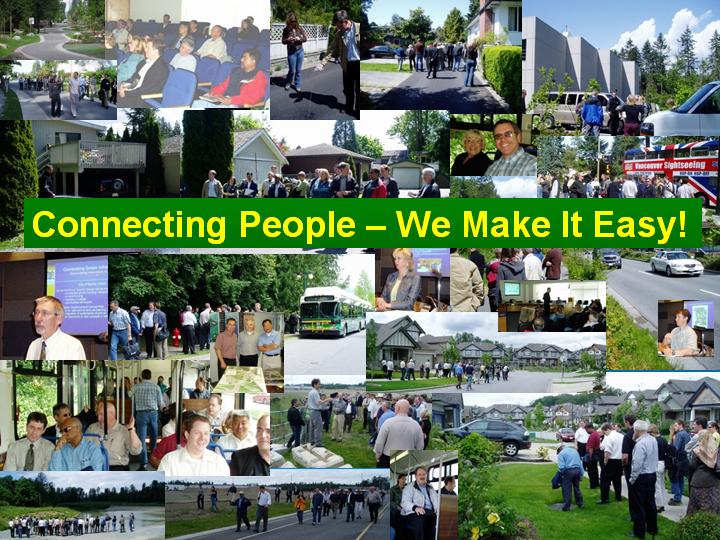UniverCity Leads Way with Next Generation of Green Infrastructure Innovation
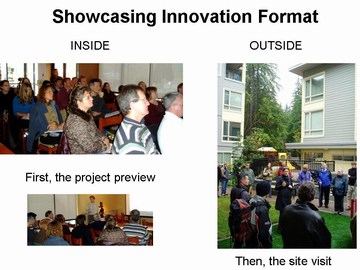
The event theme for Celebrating Green Infrastructure is “A Partnership in Action: from Vision to Implementation”
The projected growth of the Metro Vancouver region and resulting cumulative impacts are drivers for reassessing how land is developed and water is used. To promote a new way-of-thinking related to infrastructure policies and practices, the Green Infrastructure Partnership has organized Showcasing Green Infrastructure Innovation in Greater Vancouver: The 2007 Series.
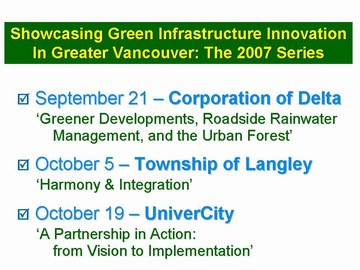
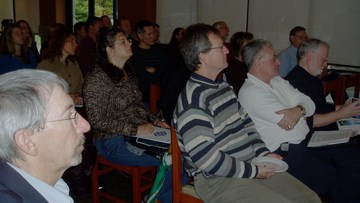
The Showcasing Innovation Series
The Showcasing Innovation Series comprises three one-day events. Each is structured as presentations in the morning and a tour of project sites in the afternoon. The third in the series was hosted by UniverCity – the Community at Simon Fraser.
To view a previous story, click on UniverCity will host third in ’2007 Showcasing Green Infrastructure Innovation Series’.
The goal in showcasing innovation and celebrating successes is to promote networking, build regional capacity, and move ‘from awareness to action’ – through sharing of green infrastructure approaches, tools, experiences and lessons learned as an outcome of designing with nature.
 “The Showcasing Innovation Series is a regional pilot program that is being implemented by the Green Infrastructure Partnership under the umbrella of the Water Sustainability Action Plan for British Columbia,” reports Kim Stephens, Series organizer and event Moderator, and Program Coordinator for the Action Plan.
“The Showcasing Innovation Series is a regional pilot program that is being implemented by the Green Infrastructure Partnership under the umbrella of the Water Sustainability Action Plan for British Columbia,” reports Kim Stephens, Series organizer and event Moderator, and Program Coordinator for the Action Plan.
Showcasing Innovation at UniverCity
The UniverCity event was titled “A Partnership in Action: from Vision to Implementation”. The UniverCity showcasing program comprised a set of four context presentations followed by a walkabout. The presentation team comprised:
- Chris Hartman, Vice-President of the SFU Community Trust
- Dale Mikkelsen, Manager of Planning and Sustainability
- David Reid, an original member of the ‘green team’ that developed the environmental component of the UniverCity Development Plan
![]() According to Chris Hartman, “UniverCity is living up to expectations…the vision for a sustainable community has quickly come to fruition: UniverCity is walkable; provides families with a sense of community in a healthy environment; supports economic development and jobs; and offers a range of housing, commercial, and transportation options”.
According to Chris Hartman, “UniverCity is living up to expectations…the vision for a sustainable community has quickly come to fruition: UniverCity is walkable; provides families with a sense of community in a healthy environment; supports economic development and jobs; and offers a range of housing, commercial, and transportation options”.
 According to Dale Mikkelsen, “The walkabout provided participants with an on-the-ground understanding of implementation details. A highlight of the walkabout was the Verdant non-market housing project, a precedent-setting green building. Verdant is precedent-setting because it will be the first LEED Gold woodframe residential building in North America.”
According to Dale Mikkelsen, “The walkabout provided participants with an on-the-ground understanding of implementation details. A highlight of the walkabout was the Verdant non-market housing project, a precedent-setting green building. Verdant is precedent-setting because it will be the first LEED Gold woodframe residential building in North America.”
To download a copy of a handout that contains program information for the Showcasing Innovation Series, the UniverCity agenda, and other pertinent information relating to the Green Infrastructure Partnership and the Water Sustainability Action Plan, click on this link to UniverCity Showcasing Innovation Handout.
About the SFU Community Trust
Formerly known as the Burnaby Mountain Community Corporation, ithe SFU Community Trust was incorporated in February 1999 and is a wholly owned subsidiary of Simon Fraser University.
The mandate of the SFU Community Trust is to manage the planning and development of a complete new community on approximately 65 hectares (160 acres) of land surrounding the SFU campus on Burnaby Mountain.
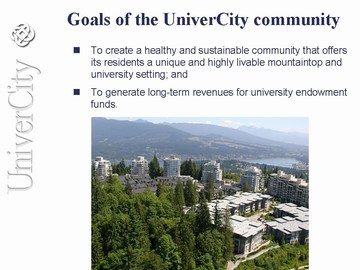
Setting the Context
Paul Ham, Chair of the Green Infrastructure Partnership, and Kim Stephens set the scene for the day. First, Paul Ham described the genesis for the Showcasing Innovation Series and how it is resonating with local governments in Metro Vancouver and on Vancouver Island. Then Kim Stephens drew on his personal experience to explain the strategic importance of UniverCity in both the regional and provincial contexts.
Connecting People
According to Paul Ham, General Manager of Engineering for the City of Surrey, “The purpose of the Showcasing Innovation Series is to celebrate… and build on…the on-the-ground successes that are enhancing the ways communities are being developed and water is being managed.”
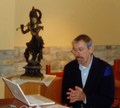 “There are a lot of good things happening throughout Metro Vancouver,” continued Paul Ham, “Because people are so busy in their own world, it takes a third party to connect them. That is the role the Green Infrastructure Partnership plays in organizing the Showcasing Innovation Series. The goal is a simple one: build regional capacity.”
“There are a lot of good things happening throughout Metro Vancouver,” continued Paul Ham, “Because people are so busy in their own world, it takes a third party to connect them. That is the role the Green Infrastructure Partnership plays in organizing the Showcasing Innovation Series. The goal is a simple one: build regional capacity.”
To download a copy of Paul Ham’s PowerPoint presentation, please click on this link to Convening for Action to Change the Way We Develop Land: Design with Nature. For the complete story that accompanies and describes each slide in the presentation, please click here.
Overcoming Fear and Doubt
Kim Stephens drew on his Burnaby Mountain experience to tell a story about a meeting with Burnaby City Council that provided the flavour of what it was like to be in the hot seat when introducing a new way of thinking and doing in 2000. This was at the start of the UniverCity development process. His theme was UniverCity: The Genesis for RAINwater Management in British Columbia.
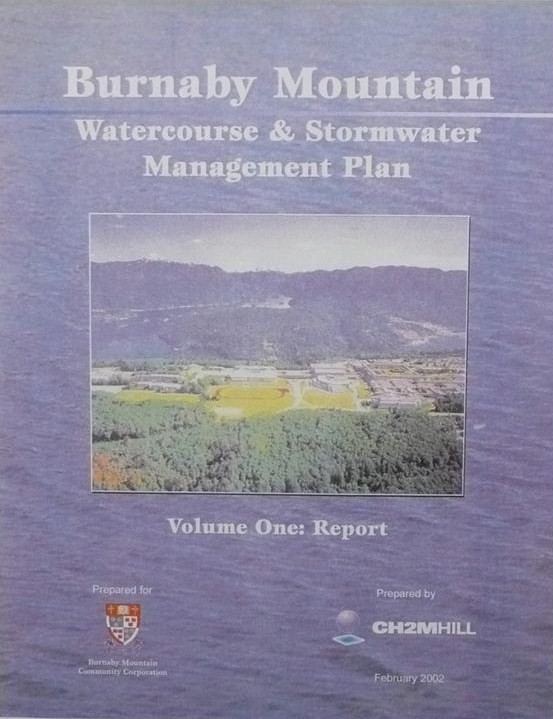 Kim Stephens was Project Manager and leader of the ‘green team’ for the Burnaby Mountain Watercourse and Stormwater Management Plan, a core component of the UniverCity Development Plan. Prior to that, he was a member of the interdisciplinary team that prepared the 1996 Development Concept Plan. This provided the technical foundation for the subsequent Simon Fraser Official Community Plan.
Kim Stephens was Project Manager and leader of the ‘green team’ for the Burnaby Mountain Watercourse and Stormwater Management Plan, a core component of the UniverCity Development Plan. Prior to that, he was a member of the interdisciplinary team that prepared the 1996 Development Concept Plan. This provided the technical foundation for the subsequent Simon Fraser Official Community Plan.
“During the 2000-2001 period we had to overcome fear and doubt in order to move ahead with projects such as the East Clayton Sustainable Community in Surrey, and UniverCity on Burnaby Mountain,” stated Stephens, “It was David Reid who coined the overcoming fear and doubt mantra; it stuck and became part an integral part of the UniverCity story.”
“By early 2001, we were literally hanging on by our fingernails,” explained Stephens. “At the time, it was Patrick Condon who said…“if we fail, it will be a generation before anyone will even have the opportunity to try again; so we must not fail”…Well, we did not fail! And because we succeeded with East Clayton and UniverCity, those hard-fought successes have ultimately made it possible to change land development practices to capture rain where it falls.”
To read more about the history of overcoming fear and doubt to implement changes in infrastructure standards, please click here. Also, click on this link to Burnaby Mountain Sustainable Community: Overcoming Fear and Doubt, and Managing Stormwater at the Source to download a copy of the paper that was presented at the Watershed 2002 Conference. Organized by the Water Environment Federation, the 2002 conference was held in Fort Lauderdale, Florida.
Innovation on Burnaby Mountain:
The Watershed 2002 paper compared traditional rainwater/stormwater management approaches to urban development with the approach applied at Burnaby Mountain. It discussed how project planning included science-based rainfall capture criteria that clarified rainwater/stormwater objectives for the development.
The paper showed how the UniverCity system balances storage on private development parcels, on-street storage and downstream detention using a full range of best management practices, ranging from in-building cisterns, to absorptive landscape soils, to constructed wetlands.
The Burnaby Mountain experience is highlighted in the book Dancing with the Tiger: Learning Sustainability Step by Natural Step, written by Brian Nattrass and Mary Altomare in 2002.
Stoney Creek Management Plan:
Kim Stephens served as an infrastructure advisor, first to Simon Fraser University and then to UniverCity, from 1979 through 2002. During this period, he was also Project Manager for the inter-municipal Stoney Creek Integrated Stormwater Management Plan. Because Simon Fraser University is situated at the top of the Stoney Creek drainage system, the Stoney Creek plan established the rainwater management criteria and set the bar for the community development that has followed at UniverCity.
The Stoney Creek plan was the pilot for ISMPs (Integrated Stormwater Management Plans) in the Greater Vancouver region, and was awarded the 2000 Environmental Award by the Association of Professional Engineers of British Columbia. For context, please click on the following link to download Still Creek-Brunette River Information Sheet #1 – Stormwater Management at a Watershed Scale , published in Summer-Fall 2001.
UniverCity Program
According to Chris Hartman, “Once we got involved in the Showcasing Innovation Series, we decided to address two aspects of this complete, compact community: first, why we are green; and secondly, what we are doing to implement green infrastructure, both now and in the future.”
” In terms of the why part, there are three dimensions…zoning, infrastructure and consumer demand for green,” continued Chris, “When we say infrastructure, we mainly mean the rainwater/stormwater system.”
The core program comprised a set of four cascading presentations that described past, present and future initiatives. Please click on the links below to access the PowerPoint slideshow for each segment.
- Segment 1 – Building a Community: Creating a Sense of Place – Living in a sustainable community means having shops, services and amenities within walking distance to your home. Now that the built environment at UniverCity is taking shape, the emphasis shifts to creating the cultural environment. Chris Hartmandescribed goals, principles and considerations that have shaped the UniverCity Development Plan and its implementation.Chris Hartman informed the audience that it was nine years ago when former SFU President John Stubbs outlined the vision for this community by saying: “The University intends to design and develop a model community…that will bring international acclaim, both to the university and to the City of Burnaby.”

- Segment 2 – HISTORY of a leading application of stormwater management
– In 2000, translating high expectations for UniverCity into practical design guidelines meant revisiting accepted drainage engineering practice. David Reid elaborated on the details of the precedent-setting plan for rainwater management and watercourse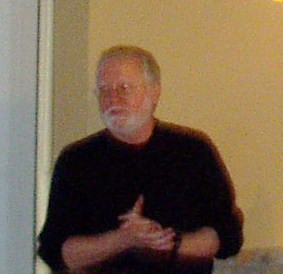 enhancement ….that set in motion a chain of outcomes that has resulted in British Columbia being recognized internationally as a leader in achieving ‘design with nature’ outcomes in an urban environment.”UniverCity provided an opportunity to demonstrate how a new, sustainable community can integrate rainwater/stormwater and watercourse management with urban design, starting where the water lands,” observed David Reid when he expanded on the introductory remarks by Kim Stephens. The high expectations for the project were not just held by the university community. The lands fall within the area of two watershed management pilot projects – the Brunette Basin Plan and the Stoney Creek Plan. These plans established demanding objectives for integrated RAINwater management. To learn more about solving challenges by starting at the source – where the rain lands, please click here.
enhancement ….that set in motion a chain of outcomes that has resulted in British Columbia being recognized internationally as a leader in achieving ‘design with nature’ outcomes in an urban environment.”UniverCity provided an opportunity to demonstrate how a new, sustainable community can integrate rainwater/stormwater and watercourse management with urban design, starting where the water lands,” observed David Reid when he expanded on the introductory remarks by Kim Stephens. The high expectations for the project were not just held by the university community. The lands fall within the area of two watershed management pilot projects – the Brunette Basin Plan and the Stoney Creek Plan. These plans established demanding objectives for integrated RAINwater management. To learn more about solving challenges by starting at the source – where the rain lands, please click here.
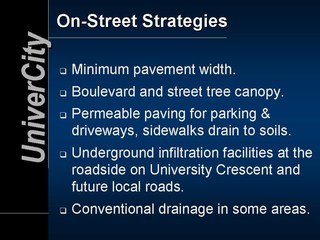
- Segment 3 – Green Infrastructure and Adaptive Management: Learning by Doing – UniverCity is a pioneer application in North America of ‘adaptive management’ in a local government setting. The goal of adaptive management is to learn by doing and constantly improve. Chris Hartman provided a very interesting look at traditional City
 of Burnaby standards, contrasted with the solutions implemented at UniverCity, and described how lessons learned are being reflected in engineering designs for successive phases. His focus was on the rainwater/stormwater management system.Chris Hartman provided on-the-ground specifics of how learning by doingis leading to changes in engineering design practices – for example, improving infiltration in sandstone by over-excavating on uphill sites.The original UniverCity Adaptive Mangement Committee incorporated the understanding gained from research undertaken for King County in 1999; as well as from parallel work on performance monitoring that was completed as part of the development process for Stormwater Planning: A Guidebook for British Columbia. To read a comprehensive story that elaborates on the technical and philosophical basis for the British Columbia approach to Adaptive Management, please click here.
of Burnaby standards, contrasted with the solutions implemented at UniverCity, and described how lessons learned are being reflected in engineering designs for successive phases. His focus was on the rainwater/stormwater management system.Chris Hartman provided on-the-ground specifics of how learning by doingis leading to changes in engineering design practices – for example, improving infiltration in sandstone by over-excavating on uphill sites.The original UniverCity Adaptive Mangement Committee incorporated the understanding gained from research undertaken for King County in 1999; as well as from parallel work on performance monitoring that was completed as part of the development process for Stormwater Planning: A Guidebook for British Columbia. To read a comprehensive story that elaborates on the technical and philosophical basis for the British Columbia approach to Adaptive Management, please click here.

- Segment 4 – Green Zoning and Planning –UniverCity is implementing innovative new zoning policies, mandatory green building requirements, and new density
 bonusing program that has been developed in partnership with the City of Burnaby. The approach that UniverCity is taking will achieve a LEED Silver equivalent. Dale Mikkelsenelaborated on the progression from guidelines to requirements so that site developers will clearly understand what is expected of them.
bonusing program that has been developed in partnership with the City of Burnaby. The approach that UniverCity is taking will achieve a LEED Silver equivalent. Dale Mikkelsenelaborated on the progression from guidelines to requirements so that site developers will clearly understand what is expected of them.
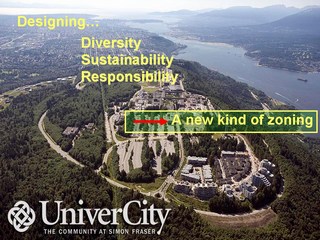
Site Walkabout
The walkabout provided an opportunity for participants to learn about the Verdant building.  Heather Tremain told the story of the project. According to Heather, “The many innovative environmental features in Verdant include the strategies utilized to ensure a greater than 60% increase in energy efficiency.”
Heather Tremain told the story of the project. According to Heather, “The many innovative environmental features in Verdant include the strategies utilized to ensure a greater than 60% increase in energy efficiency.”
“The Verdant building is also a non-market project that was built for SFU faculty and staff with an innovative land transfer and sales component that will ensure affordability throughout the life of the project,” reported Chris Hartman.
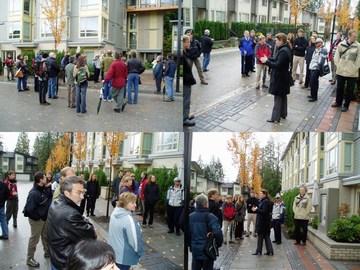
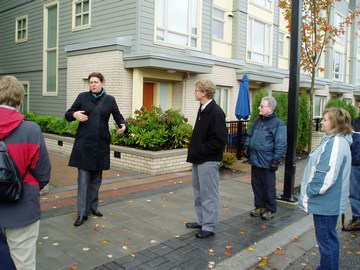
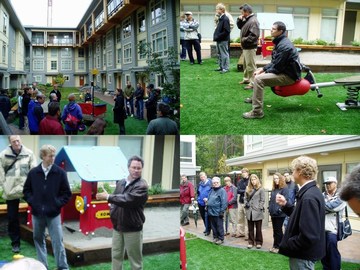
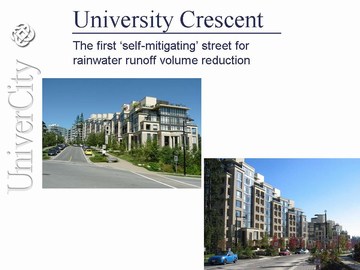
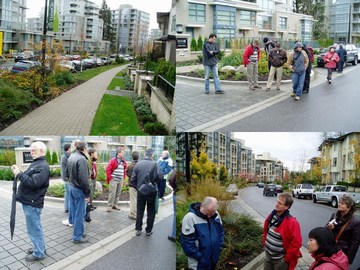
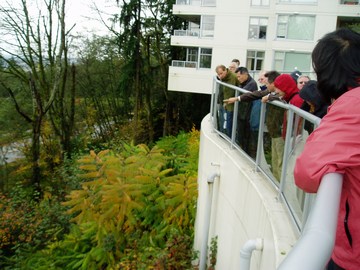
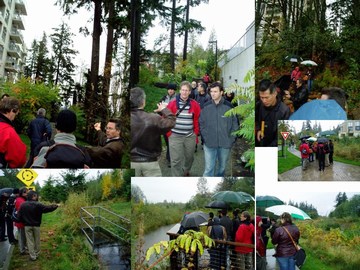
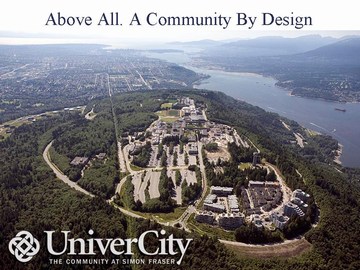
Posted October 2007



